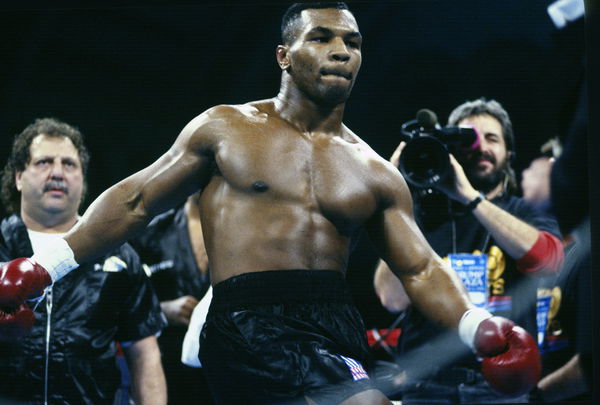
via Getty
ATLANTIC CITY, NJ – DECEMBER 8: Heavyweight fighter Mike Tyson enters the ring before he faces Alex Stewart in a ten round heavyweight fight December 8, 1990 at the Convention Center in Atlantic City, New Jersey. Tyson won the fight with a KO in the first round. (Photo by Focus on Sport/Getty Images)

via Getty
ATLANTIC CITY, NJ – DECEMBER 8: Heavyweight fighter Mike Tyson enters the ring before he faces Alex Stewart in a ten round heavyweight fight December 8, 1990 at the Convention Center in Atlantic City, New Jersey. Tyson won the fight with a KO in the first round. (Photo by Focus on Sport/Getty Images)
Stepping into the shoes of Mike Tyson feels like entering a battlefield. Tyson, a boxing legend, sculpted not just in the ring but in relentless dawn workouts. Imagine running miles before the sun peeks, then hours in the gym, honing ferocity with every punch. Now, picture Daru Strong, a strength and conditioning coach, diving into this punishing routine.
Watch What’s Trending Now!
It’s not just an exercise in physical endurance, but a journey into the psyche of a champion. Strong, equipped with modern training wisdom, confronts Tyson’s old-school methods. What happens when contemporary fitness meets a routine from the past?
ADVERTISEMENT
Article continues below this ad
Strong’s Breakdown of Mike Tyson’s Routine
Diving into the specifics, Daru Strong meticulously dissects Tyson’s legendary workout. “We’re gonna go over the breakdown of Mike Tyson’s routine,” he begins. His voice carries a mix of respect and curiosity as he details the regimen: the 4 am runs spanning 3-5 miles, a staple in Tyson’s fight camp. This early exertion set the stage for the rest of the day’s grueling activities.
ADVERTISEMENT
Article continues below this ad
Strong highlights the intensity of Tyson’s gym sessions: “After that 4 am run he would go back home, get some rest probably take a nap, wake up have breakfast, and then go to the boxing gym for around a 3-hour session.“ These weren’t ordinary gym visits. Tyson engaged in 10-12 rounds of sparring, each lasting 3 minutes, and then dedicated 20-30 minutes to jump ropes.
But the strain didn’t end there. Strong underscores the sheer volume of Tyson’s calisthenics routine before dinner. “This is when he did his calisthenics 10-round circuit,” Strong explains. The cumulative daily reps are staggering: 2000 decline sit-ups, 500 bench dips, 500 push-ups, 500 shrugs with a 30 kg barbell, and 10 minutes of neck exercises in the ring. This exhaustive list paints a vivid picture of the physical demands placed on Tyson, encapsulating the essence of his training philosophy.
ADVERTISEMENT
Article continues below this ad
Evaluating the Pros and Cons
Transitioning from the rigorous breakdown, Daru Strong shifts to a critical analysis of Tyson’s routine, weighing its strengths and weaknesses.
“It puts you in the mind frame just like Mike needed to be the best boxer, the best fighter in the world,” he asserts, acknowledging the psychological fortitude required in boxing. The relentless nature of the workout, he observes, is not just about physical pain but also about pushing forward, a testament to Tyson’s unyielding spirit. Strong adds, “It’s just pain, and you gotta keep moving forward.” This endurance, he believes, equips one with the mindset to endure any challenge, encapsulating the essence of a fighter’s spirit.
However, Strong doesn’t shy away from pointing out the routine’s shortcomings. He notes, “The repetitive motion of the exercises he did,” highlighting the potential risks of such monotony, which could lead to muscular imbalances or injuries. Furthermore, he criticizes the anterior dominance of the exercises. To rectify this, Strong suggests incorporating more exercises that target the back or posterior areas, like pull-ups and rowing movements. “I would like to see more posterior chain work,” he explains, emphasizing the importance of a well-rounded training approach.
In this analytical discourse, Strong bridges the gap between old-school training rigors and modern fitness principles, offering a nuanced view of Tyson’s iconic routine.
Also Read: Mike Tyson’s Legacy as ‘Great’ Questioned; Teddy Atlas Explains Who Is ‘Truly Great’Do you think you would be able to survive Iron Mike’s workout? Have you ever tried to do it? Let us know in the comments.
Watch this story: Five Infamous Altercations of Mike Tyson outside the RingADVERTISEMENT
ADVERTISEMENT
ADVERTISEMENT
ADVERTISEMENT

